Introduction to Economics
Cambridge College
Page 4 out of 639 results
Sort by
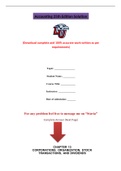
-
Business Accounting
- Summary • 43 pages • 2022
-
- $15.99
- + learn more
1. No. Common stock with a higher par is not necessarily a better investment than common stock with a lower par because par is an amount assigned to the shares. 2. The broker is not correct. Corporations are not legally liable to pay dividends until the dividends are declared. If the company that issued the preferred stock has operating losses, it could omit dividends, first, on its common stock and, later, on its preferred stock. 3. The company may not have had enough cash on hand to p...
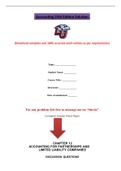
-
Business Accounting
- Summary • 52 pages • 2022
-
- $15.99
- + learn more
1. a. Proprietorship: Ease of formation and nontaxable entity. b. Partnership: Expanded owner expertise and capital, nontaxable entity, and moderate complexity of formation. c. Limited liability company: Limited liability to owners, expanded access to capital, nontaxable entity, and moderate complexity of formation. 2. The disadvantages of a partnership are that its life is limited, each partner has unlimited liability, one partner can bind the partnership to contracts, and raising...
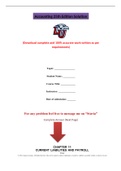
-
Business Accounting
- Summary • 41 pages • 2022
-
- $7.99
- + learn more
1. No. A discounted note payable has no stated interest rate, but provides interest by discounting the note proceeds. The discount, which is the difference between the proceeds and the face of the note, is the interest and is accounted for as such. 2. a. Employee’s federal income taxes, social security, and Medicare b. Employees Federal Income Tax Payable, Social Security Tax Payable, and Medicare Tax Payable 3. The deductions from employees’ earnings are for amounts owed (liabiliti...
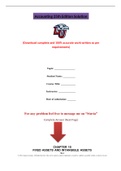
-
Business Accounting
- Summary • 35 pages • 2022
-
- $15.99
- + learn more
1. a. Property, plant, and equipment or Fixed assets b. Current assets (merchandise inventory) 2. Real estate acquired as speculation should be listed in the balance sheet under the caption “Investments,” below the Current Assets section. 3. $1,100,000 4. Capital expenditures include the cost of acquiring fixed assets and the cost of improving an asset. These costs are recorded by increasing (debiting) a fixed asset account. Capital expenditures also include the costs of ext...
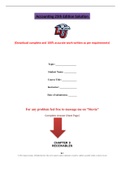
-
Business Accounting
- Summary • 47 pages • 2022
-
- $15.99
- + learn more
1. Receivables are normally classified as (1) accounts receivable, (2) notes receivable, or (3) other receivables. 2. Dan’s Hardware should use the direct write-off method because it is a small business that has a relatively small number and volume of accounts receivable. 3. Contra asset, credit balance 4. The accounts receivable and allowance for doubtful accounts may be reported at a net amount of $661,500 ($673,400 – $11,900) in the Current Assets section of the balance shee...
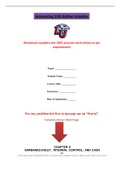
-
Business Accounting
- Summary • 37 pages • 2022
-
- $15.99
- + learn more
a. The five elements of internal control are the control environment, risk assessment, control procedures, monitoring, and information and communication. The control environment is the overall attitude of management and employees about the importance of controls. Risk assessment includes evaluating various risks facing the business, including competitive threats, regulatory changes, and changes in economic factors. Control procedures are established to provide reasonable assurance that busines...
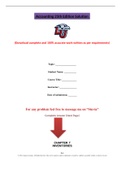
-
Business Accounting
- Summary • 56 pages • 2022
-
- $17.99
- + learn more
1. The receiving report should be reconciled to the initial purchase order and the vendor’s invoice before recording or paying for inventory purchases. This procedure will verify that the inventory received matches the type and quantity of inventory ordered. It also verifies that the vendor’s invoice is charging the company for the actual quantity of inventory received at the agreed-upon price. 2. A physical inventory should be taken periodically to test the accuracy of the perpetual re...
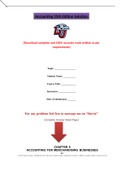
-
Business Accounting
- Summary • 87 pages • 2022
-
- $15.99
- + learn more
1. Merchandising businesses acquire merchandise for resale to customers. It is the selling of merchandise, instead of a service, that makes the activities of a merchandising business different from the activities of a service business. 2. Yes. Gross profit is the excess of (net) sales over cost of merchandise sold. A net loss arises when operating expenses exceed gross profit. Therefore, a business can earn a gross profit but incur operating expenses in excess of this gross profit and end u...
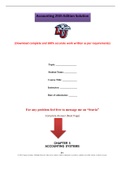
-
Business Accounting
- Summary • 77 pages • 2022
-
- $15.99
- + learn more
The individual accounts receivable ledger accounts provide business managers information on the status of individual customer accounts, which is necessary for managing collections. Managers need to know which customers owe money, how much they owe, and how long the amount owed has been outstanding. 2. The major advantages of the use of special journals are substantial savings in record-keeping expenses and a reduction of record-keeping errors. 3. a. 400 b. None 4. a. 400 b. 1 ...
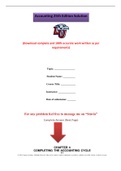
-
Business Accounting
- Summary • 127 pages • 2022
-
- $8.99
- + learn more
1. The end-of-period spreadsheet illustrates the flow of accounting information from the unadjusted trial balance into the adjusted trial balance and into the financial statements. In doing so, the spreadsheet illustrates the impact of the adjustments on the financial statements. 2. a. Current assets are composed of cash and other assets that may reasonably be expected to be realized in cash or sold or used up, usually within one year or less, through the normal operations of the business...

How did he do that? By selling his study resources on Stuvia. Try it yourself! Discover all about earning on Stuvia


